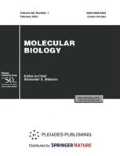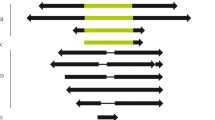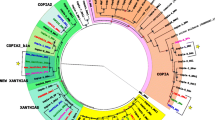Abstract
The mobile element Penelopeis activated and mobilizes several other transposons in dysgenic crosses in Drosophila virilis. Its structure proved to be complex and to vary greatly in all examined species of the virilisgroup. Phylogenetic analysis of the reverse transcriptase (RT) domain assigned Penelopeto a new branch, rather than to any known family, of LTR-lacking retroelements. Amino acid sequence analysis showed that the C-terminal domain of the Penelopepolyprotein is an active endonuclease, which is related to intron-encoded endonucleases and to bacterial repair endonuclease UrvC, and may act as an integrase. Retroelements coding for a putative endonuclease that differs from typical integrase have not been known thus far. Phylogenetic analysis divided the Penelopecopies from several virilisspecies into two subfamilies, one including virtually identical full-length copies, and the other comprising highly divergent defective copies. The results suggest both vertical and horizontal transfer of the element. Possibly, Penelopeinvasion recurred during evolution and contributed to genome rearrangement in the virilisspecies. Chromosome aberrations detected in D. virilis, which is now being invaded by Penelope, is direct evidence for this assumption.
Similar content being viewed by others
References
Patterson, J. and Stone, W., Evolution in the Genus Drosophila, New York: Macmillan, 1952.
Spicer, G., Ann. Ent. Soc. Am., 1992, vol. 85, pp. 11–25.
Evgen'ev, M.B., Mndzhoyan, E.I., Zelentsova, E.S., et al., Mol. Biol., 1998, vol. 32, pp. 184–192.
Gall, J.G. and Atherton, D.D., J. Mol. Biol., 1974, vol. 85, pp. 633–664.
Cohen, E. and Bowman, S., Chromosoma, 1979, vol. 73, pp. 327–355.
Arkhipova, I., Lyubomirskaya, N., and Ilyin, Y., Retroposons of Drosophila, Austin, Tex.: Landes, 1995.
Anxolabéhére, D., Kidwell, M., and Pèriquet, G., Mol. Biol. Evol., 1988, vol. 5, pp. 252–269.
Kidwell, M., J. Hered., 1994, vol. 85, pp. 339–346.
Evgen'ev, M., Yenikopolov, G., Peunova, N., and Ilyin, Y., Chromosoma, 1982, vol. 85, pp. 375–386.
Scheinker, V., Lozovskaya, E., Bishop, J., et al., Proc. Natl. Acad. Sci. USA, 1990, vol. 87, pp. 9615–9619.
Petrov, D., Schutzman, J., Hartl, D., and Lozovskaya, E., Proc. Natl. Acad. Sci. USA, 1995, vol. 92, pp. 8050–8054.
Evgen'ev, M., Zelentsova, H., Shostak, N., et al., Proc. Natl. Acad. Sci. USA, 1997, vol. 94, pp. 196–201.
Vieira, J., Vieira, C.P., Hartl, D.L., and Lozovskaya, E.R., Genet. Res., 1998, vol. 71, pp. 109–117.
Kidwell, M., Kidwell, J., and Sved, J., Genetics, 1977, vol. 36, pp. 813–833.
Lozovskaya, E., Scheinker, V., and Evgen'ev, M., Genetics, 1990, vol. 126, pp. 619–623.
Evgen'ev, M., Zelentsova, H., Mnjoian, L., et al., Chromosoma, 2000, vol. 109, pp. 350–357.
Lim, J., Dros. Inf. Serv., 1993, vol. 72, pp. 73–77.
Gubenko, I. and Evgen'ev, M., Genetica, 1984, vol. 65, pp. 127–139.
Altschul, S., Madden, T., Schaffer, A., et al., Nucleic Acids Res., 1997, vol. 25, pp. 3389–3402.
Felsenstein, J., Methods Enzymol., 1996, vol. 266, pp. 418–427.
Thompson, J., Gibson, T., Plewniak, F., et al., Nucleic Acids Res., 1997, vol. 25, pp. 4876–4882.
Zelentsova, H., Poluectova, H., Mnjoian, L., et al., Chromosoma, 1999, vol. 108, pp. 443–456.
Xiong, Y. and Eickbush, T., EMBO J., 1990, vol. 90, pp. 3353–3362.
Aravind, L., Walker, D., and Koonin, E., Nucleic Acids Res., 1999, vol. 27, pp. 1223–1242.
Malik, H. and Eickbush, T., Genetics, 2000, vol. 145, pp. 193–203.
Koonin, E., Mushegian, A., and Bork, P., Trends Genet., 1996, vol. 12, pp. 334–336.
Capy, P., Anxolabehere, D., and Langin, T., Trends Genet., 1994, vol. 10, pp. 7–12.
Zelentsova, E., Vashakidze, R., Kraev, A., and Evgen'ev, M., Chromosoma, 1986, vol. 93, pp. 469–476.
Tsuno, K. and Yamaguchi, O., Jpn. J. Genet., 1991, vol. 66, pp. 49–58.
Author information
Authors and Affiliations
Rights and permissions
About this article
Cite this article
Lezin, G.T., Makarova, K.V., Velikodvorskaya, V.V. et al. The Structure and Evolutionary Role of the PenelopeMobile Element in the Drosophila virilisSpecies Group. Molecular Biology 35, 682–690 (2001). https://doi.org/10.1023/A:1012370103209
Issue Date:
DOI: https://doi.org/10.1023/A:1012370103209




